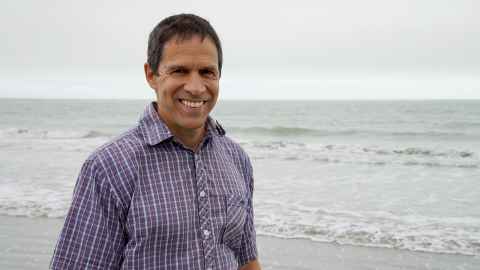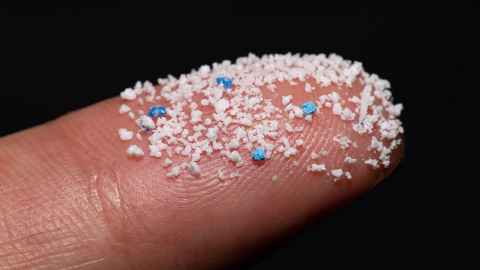Plastic leachate at the base of food web
21 April 2020
Are microplastics disrupting the tiny creatures crucial to the health of the marine food web?



A tiny crustacean that’s been around for hundreds of millions of years is suddenly encountering the microplastic onslaught in our oceans and rivers.
Now, a five-year study in New Zealand led by toxicologist Dr Louis Tremblay in Nelson will test what happens when the animal, called a copepod, eats that plastic – with potential implications for the rest of the food chain, including humans.
The scientist, who works for the Cawthron Institute in Nelson and the University of Auckland, is zeroing in on chemicals leaching out from microplastics that float around in our rivers and oceans, slowly weathering and degrading. He’ll check whether the chemicals may disrupt basic functions such as molting and reproduction.
Sometimes called the insect of the sea because of its ubiquity, the copepod is eaten by the likes of mussels, snapper and kahawai – all regulars on the New Zealand dinner table and in our exports. As one of the most numerous marine animals, the copepod is a major food source for fish all over the world found almost anywhere bodies of water exist in the wild.
Global research to accumulate evidence on the effects of plastics on animals and humans has exploded in the past decade after their particles penetrated into every reach of the natural world. The New Zealand research will add to that knowledge but also have a local twist, since Tremblay’s team will work with two native species of the crustacean:
- Quinquelaophonte aurantius, which lives in sediment in the ocean and fresh water
- Gladioferens pectinatus, which lives higher up in both environments
"What’s important for us is to make sure that the research we’re doing is relevant to our unique eco-system,” says Tremblay. New Zealand needs to tackle "having all these microplastics in our beautiful environment,” he says.
For New Zealand, the economic stakes are especially high, with the image of "pure" seafood exports at stake – a risk flagged in a 2019 report from the office of the Prime Minister’s Chief Science Advisor.
Besides working with native species, the locally-focused approach means testing chemicals from the types of plastic typically found in New Zealand waterways, such as polyethylene terephthalate (PET), used in plastic bottles for soft drinks, juice and water.
Bisphenol A (BPA) is among the best known and most worrying additives, increasing the strength and transparency of plastic bottles, but also serving as an endocrine disruptor, interfering with hormones in animals and humans. There are hundreds, maybe thousands, more of the additives, such as ultraviolet blockers, flame retardants, antioxidants, heat stabilizers, anti-foulants, dyes and pigments.
"Chemicals are actually added – they’re not bound in the matrix – so they can slowly leach out,” explains Tremblay. "This is the angle we’re taking. If you have the presence of microplastics, how does the leaching of those additives lead to some potential impacts on the exposed organisms?”
For now, the world’s knowledge of the health effects of microplastics is limited. The best available evidence suggests there isn’t a widespread risk to humans or the environment – at least, not yet, according to a European report in 2019. However, scientific advisers to the European Commission also noted that much more information was needed to get a fix on the problem, highlighting the existing mix of “consensus, contested knowledge, informed extrapolation, speculation and many unknowns.”
Economic stakes
For New Zealand, the economic stakes are especially high, with the image of "pure” seafood exports at stake – a risk flagged in a 2019 report from the office of the Prime Minister’s Chief Science Advisor.
For now, Tremblay’s team is searching through the international literature to choose two or three chemicals for study. One possibility is one of the phthalates, a group of plasticizers that, like BPA, are under scrutiny globally for disrupting hormones. Used for everything from toys to shampoos to vinyl floor coverings, phthalates have been suspected of triggering via prenatal exposure such effects as lowered testosterone and sperm quality for boys and, according to an American study released in January this year, lower motor skills in girls.
Another possible candidate is BPA. “With BPA, the most likely effects will be related to reproduction, Tremblay says. “Once we have a good understanding, we’ll start going in the wild to see whether we can see those same effects.’’

The tiny copepod, barely visible to the naked eye, is an ideal animal for the research because of its ubiquity worldwide and crucial role in the food chain. The macroinvertebrate – the term for animals which lack backbones but are big enough to be seen by the naked eye – is the primary prey of the young fish of many commercial fish species globally.
The crustacean’s short life cycle, with a generation living for only two to three weeks, makes it easier to study if chemicals are switching genes “on” or “off,” disrupting normal processes. Tremblay’s team will check by measuring Ribonucleic acid (RNA), a molecule that carries genetic information. Using the “Omics” approach – a term covering areas of biological science such as genomics and proteomics – he’ll look not only at gene expression but also how chemical exposures may alter the copepods’ protein profiles.
"In two months, we can have four to five generations and we can look at the subtle changes,’’ he says. The scientist and his team will assess whether the creatures’ sensitivity to the chemicals diminishes over time.
Toxic effects
While microplastic chemicals’ effects on copepods won’t directly tell us what the substances may do to humans, they could be suggestive, according to Tremblay. He cites metals such as copper and cadmium as showing how toxic effects can be similar across a wide variety of species.
In the first stage of the experiments, copepods swimming in beakers at the Cawthron Institute will be exposed to the targeted chemicals to test the experiment’s design. Then, scientists at the Crown research institute Scion will take plain plastic fibres and “spike” them with the chemical additives, putting the microplastic particles into the sediment for one species and making them buoyant for the other species, which lives higher up in the water column.
Ultimately, real-world microplastic particles that contain the “right” chemicals may be used. When plastic passes through the copepods and is expelled as faeces, Tremblay and his team will be checking on what proportion of the chemical additives are retained in the organisms.
In a sign of the complexity of setting up the study, Tremblay is still completing the protocol for the experiment, as the project enters its second year. A likely follow-up after two years of experiments will be to study the potential for effects to transfer across the food web, studying what happens to, say, mussels that eat chemically affected copepods.
For Tremblay, who’s lived in New Zealand for about 20 years, an initial interest as a student in microbiology led to ecotoxicology and studying in the early 1990s at a pulp and paper institute in Canada.
“The first time I went to a pulp and paper mill, I saw that what they were releasing into the river was this pitch-dark effluent – and this is how I started. I got more and more interested in terms of characterising the risk: how are those pollutants promoting their toxic effects.”
Story by Paul Panckhurst
Researcher portrait by Bruce Green
The Challenge is a continuing series from the University of Auckland about
how our researchers are helping to tackle some of the world's biggest challenges.
To republish this article please contact: gilbert.wong@auckland.ac.nz